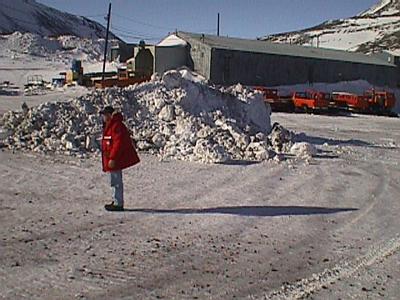20 October, 1999
How high does the sun get in the sky? Well that depends upon where
you are on the Earth, what time of day it is and what time of the year it
is. If you are in Antarctica, the sun never gets very high in the sky.
Sometimes, it never even gets above the horizon. (See yesterday's journal).
Today, I want to do a little exercise with you and compare how high the sun
gets where you live with how high it is in Antarctica. If you look at the
picture below, you will see a picture of me in McMurdo on a typical, bright
sunny day. This picture was taken on October 19th outside the Crary Lab. I
had this picture taken of me at a very specific time. It was 1:38PM NZDT.
This was solar noon at McMurdo on this day. Solar noon is the time when the
sun is exactly due north of your location in the Southern Hemisphere (due
south in the Northern Hemisphere). At this time, the sun reaches its highest
point in the sky for that day. Solar noon differs from clock time noon for
two primary reasons. First, we often move our clocks ahead an hour in the
summer. We call this daylight savings time. Also, time zones are established
over large areas of the Earth. For example, Cleveland and New York are in
the same time zone, but the sun is due north of each city at different times
of the day. I found out when solar noon was in McMurdo by contacting the
meteorologists at MacWeather. They are the people responsible for weather
forecasts in Mactown. I will be telling you more about MacWeather in a later
journal.
If you look at the picture, you will see my shadow is much longer
then I am. This is because the angle of the sun above the horizon is quite
low, even at solar noon when it is the highest for the day. If the sun were
directly overhead, I would have no shadow. When would my shadow be the same
length as I am tall? I am standing facing directly into the sun (north). If
you print out this picture you can measure my height and the length of my
shadow. (Or just measure it on the screen). I am 6 feet tall. From this
information, you should be able to figure out how long my shadow is. If you
need help, ask your science or math teacher.
Find out when solar noon is where you live. Call up the local
weather service or maybe a local college or university astronomy department.
If you can't find out from someone, you could figure it out yourself. Just
put a stick in the ground on a sunny day near noon (1:00PM if you are in
daylight savings time.) Watch the shadow of the stick. Note the time when
the shadow gets the longest. That is solar noon.
Go outside at solar noon and measure the length of your shadow.
Would my shadow be longer or shorter if I were where you live at solar noon?
Why? Middle school or high school students who have had geometry should be
able to calculate the angle of the sun from this picture. In fact, over 2000
years ago an Egyptian Librarian named Eratosthenes used similar measurements
to calculate the circumference of the Earth. For more about how you could do
the same thing, check out this web site:
http://www.geocities.com/Athens/8231/np_lessn.htm.
It was another beautiful day in McMurdo. It was sunny and pretty
windy. I went for a walk after breakfast to Hut Point. This is the location
of the hut used by Robert Falcon Scott and his team when they made their
attempt to reach the South Pole. The temperature was about 5F with the wind
gusting to 30MPH. The wind chill was about -35F. And this is a nice day! How
did those men survive in this little hut through the cold, brutal Antarctic
winter with no sun? The thought of that amazes me! See you tomorrow.

Picture of me and my shadow taken at solar noon, 1:39PM NZDT on October 19th.

A typical windy day in Mactown. Note the blowing snow and the low angle of the sun.

Contact the TEA in the field at
.
If you cannot connect through your browser, copy the
TEA's e-mail address in the "To:" line of
your favorite e-mail package.
|
